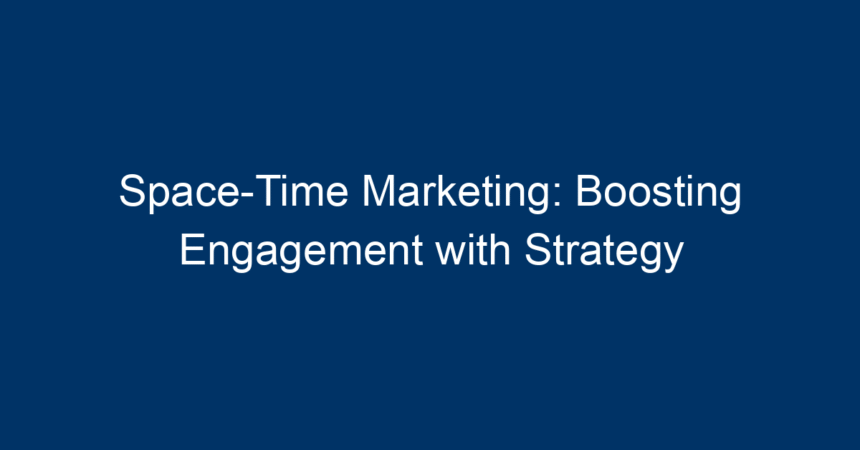In today’s fast-paced digital landscape, understanding the dynamics of time and space can significantly enhance your marketing efforts. Enter space-time marketing—a revolutionary approach that strategically leverages both the temporal and spatial dimensions to foster stronger connections with consumers. This article aims to delve into the essentials of space-time marketing, its benefits, and actionable strategies to boost engagement through effective implementation.
What is Space-Time Marketing?
Space-time marketing refers to the methodology of aligning marketing strategies with the context of time and place to optimize consumer engagement. It considers not just who your consumer is, but when and where they consume content. By targeting specific consumer behaviors in particular spatiotemporal contexts, businesses can deliver personalized experiences that resonate deeply.
The Importance of Context in Marketing
To understand space-time marketing, it’s crucial to recognize the role of context. Consumers today are inundated with information and advertisements. To stand out, brands must go beyond just traditional marketing tactics and engage with their audiences in a manner that feels relevant and timely. Contextual marketing helps create more meaningful interactions, driving higher engagement rates.
Key Principles of Space-Time Marketing
Successful space-time marketing relies on several core principles that can be categorized into three primary components: Timing, Location, and Consumer Behavior Analysis.
1. Timing: The Power of Now
Time can significantly influence consumer behavior. Timely promotions, holiday-themed campaigns, or even seasonal product offers can boost engagement. By analyzing peak times when your audience is most active and receptive, you can tailor your marketing messages to meet them where they are, literally and figuratively.
Harnessing Temporal Marketing Strategies
- Real-time Marketing: Respond to current events or trends swiftly. For instance, if a popular event occurs, relate your marketing campaign directly to it. This not only increases relevance but also positions your brand as being in tune with cultural currents.
- Time-limited Offers: Creating urgency with flash sales or limited-time offers encourages immediate action from consumers. These strategies can lead to increased conversions as they tap into the fear of missing out (FOMO).
2. Location: Meeting Customers Where They Are
Location-based marketing has emerged as a critical aspect of consumer engagement. With advancements in technology, brands can now reach consumers in very specific geographical locations, enhancing the relevance of their messaging.
Leveraging Geographic Targeting
- Geofencing: Establish geofences around key locations (like stores or events) to send targeted ads or notifications when consumers enter that space. This strategy ensures that your marketing efforts are localized and relevant.
- Localized Content: Acknowledge the cultural and regional preferences of your audience. Adjusting your messaging based on local customs and values can resonate more with potential customers.
3. Consumer Behavior Analysis: Getting to Know Your Audience
Understanding the behavior of your target audience is pivotal in space-time marketing. By employing data analytics, businesses can gain insights into preferences, habits, and patterns, allowing them to create highly tailored marketing strategies.
Using Analytics for Effective Targeting
- Behavior Analytics: Tools like Google Analytics can provide data on when and where your consumers are engaging with your content. This data can help refine your marketing strategy, focusing on high-traffic times and platforms.
- Segmented Marketing Campaigns: Divide your audience into segments based on their behaviors, preferences, and locations. Tailored messages that speak directly to each segment’s unique characteristics can lead to enhanced engagement.
The Benefits of Space-Time Marketing
Implementing a space-time marketing strategy can yield a multitude of benefits for your business, including:
1. Enhanced Engagement
By delivering targeted content at the right time and place, brands can cultivate deeper connections with consumers, increasing overall engagement.
2. Higher Conversion Rates
Tailored marketing efforts that capture the audience’s immediate needs and desires are more likely to translate into sales.
3. Improved Brand Loyalty
Engaging customers in a more personal and relevant manner fosters trust and loyalty. This can ultimately lead to long-term relationships and repeat business.
4. Better ROI
A strategic approach to space-time marketing ensures that resources are utilized effectively, leading to a higher return on investment. By focusing on context-driven marketing, businesses can avoid wastage of budgets on irrelevant campaigns.
Implementing Space-Time Marketing Strategies
Implementing space-time marketing requires actionable steps and considerations:
1. Collect and Analyze Data
Begin by gathering data on your consumers. Analyze demographics, behavior patterns, and preferences. Utilize analytical tools to continuously refine your understanding of when and where your audience engages.
2. Develop a Targeted Content Calendar
Create a content strategy that aligns with your audience’s preferred times and locations. Use insights gained from data analysis to schedule posts, promotions, and ads.
3. Test and Optimize
Regularly test different strategies and campaigns. A/B testing can help identify what resonates more with your audience. Use analytics to continuously optimize your approach based on performance metrics.
4. Leverage Technology
Utilize marketing automation platforms to deliver personalized messages in real-time. Tools that support geofencing, SMS marketing, and social media ads can greatly assist in implementing your space-time marketing strategy.
Conclusion: Actionable Insights for Your Business
Space-time marketing represents a paradigm shift in how brands engage with consumers. By strategically integrating time and location into your marketing efforts, you can increase engagement, improve conversion rates, and foster brand loyalty.
Key Takeaways:
- Know Your Audience: Utilize data analytics to understand consumer behavior deeply.
- Timing is Everything: Implement time-sensitive strategies to capture immediate interest.
- Location Matters: Tailor your marketing efforts to specific geographical areas to enhance relevance.
- Continuous Optimization: Regularly test and adjust your strategies based on performance data.
By embracing space-time marketing, your brand can cultivate meaningful interactions and navigate the complexities of the modern consumer landscape effectively. Make it a priority to weave the principles of space-time marketing into your overall strategy, and watch your engagement levels soar.




